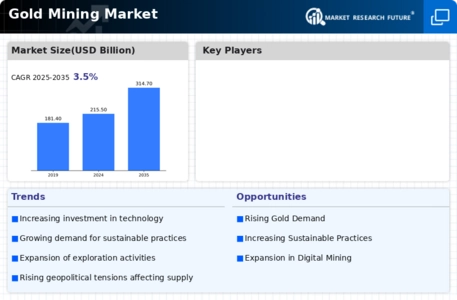Market Analysis
In-depth Analysis of Gold Mining Market Industry Landscape
The market dynamics of gold mining are influenced by various factors that shape the supply, demand, and overall trends within the mining and precious metals industry. Gold, known for its intrinsic value and historical significance, serves as a key investment asset and plays a crucial role in jewelry, electronics, and central bank reserves. Understanding the market dynamics involves examining elements such as economic conditions, geopolitical factors, technological advancements, sustainability considerations, and competitive forces.
Economic conditions play a pivotal role in the market dynamics of gold mining. As a safe-haven asset, gold demand is often influenced by economic uncertainties, inflation fears, and currency fluctuations. During periods of economic instability or uncertainty, investors tend to turn to gold as a store of value. Conversely, in times of economic growth, jewelry demand for gold may increase. The cyclical nature of gold demand makes economic conditions a primary driver in shaping market dynamics.
Geopolitical factors significantly impact the market dynamics of gold mining, given that gold deposits are distributed globally. Political stability, regulatory frameworks, and government policies can impact mining operations, exploration activities, and investment decisions. Geopolitical tensions, trade disputes, and global economic uncertainties can drive investors to seek the safety of gold, influencing its price and market dynamics. Gold mining companies must navigate geopolitical considerations to manage risks and capitalize on market opportunities.
Technological advancements are key drivers in the market dynamics of gold mining. Innovations in mining technologies, ore processing, and exploration techniques contribute to increased efficiency, reduced environmental impact, and lower production costs. Advanced technologies, such as satellite imagery, remote sensing, and data analytics, aid in prospecting and resource estimation. Sustainable mining practices and advancements in extraction methods also play a role in optimizing the overall gold mining process. Companies embracing technological advancements gain a competitive advantage in the dynamic gold mining market.
Sustainability considerations are increasingly shaping the market dynamics of gold mining. With a growing emphasis on environmental and social responsibility, mining companies are adopting sustainable practices to minimize the environmental impact of gold extraction. Responsible mining practices include biodiversity conservation, water management, and community engagement. Sustainable mining efforts contribute to the industry's ability to address concerns raised by environmentally conscious investors and comply with evolving environmental regulations.
Competitive forces are a significant aspect influencing the market dynamics of gold mining. The industry is marked by competition among mining companies, each seeking to access high-quality gold deposits and implement cost-effective extraction methods. Exploration for new gold projects, mergers and acquisitions, and operational efficiency become key factors for companies to maintain a competitive edge in the dynamic gold mining market. The ability to adapt to changing market conditions and technological advancements is crucial for success.
Fluctuations in gold prices, influenced by supply and demand dynamics, macroeconomic trends, and investor sentiment, present challenges and opportunities in the market. Gold prices can be volatile, impacting the profitability of mining operations and investment decisions. Gold producers must employ strategic planning, risk management strategies, and stay informed about market trends to navigate the price volatility inherent in the gold mining industry.


 Source: Secondary Research, Primary Research, Market Research Future Database and Analyst Review
Source: Secondary Research, Primary Research, Market Research Future Database and Analyst Review
Leave a Comment